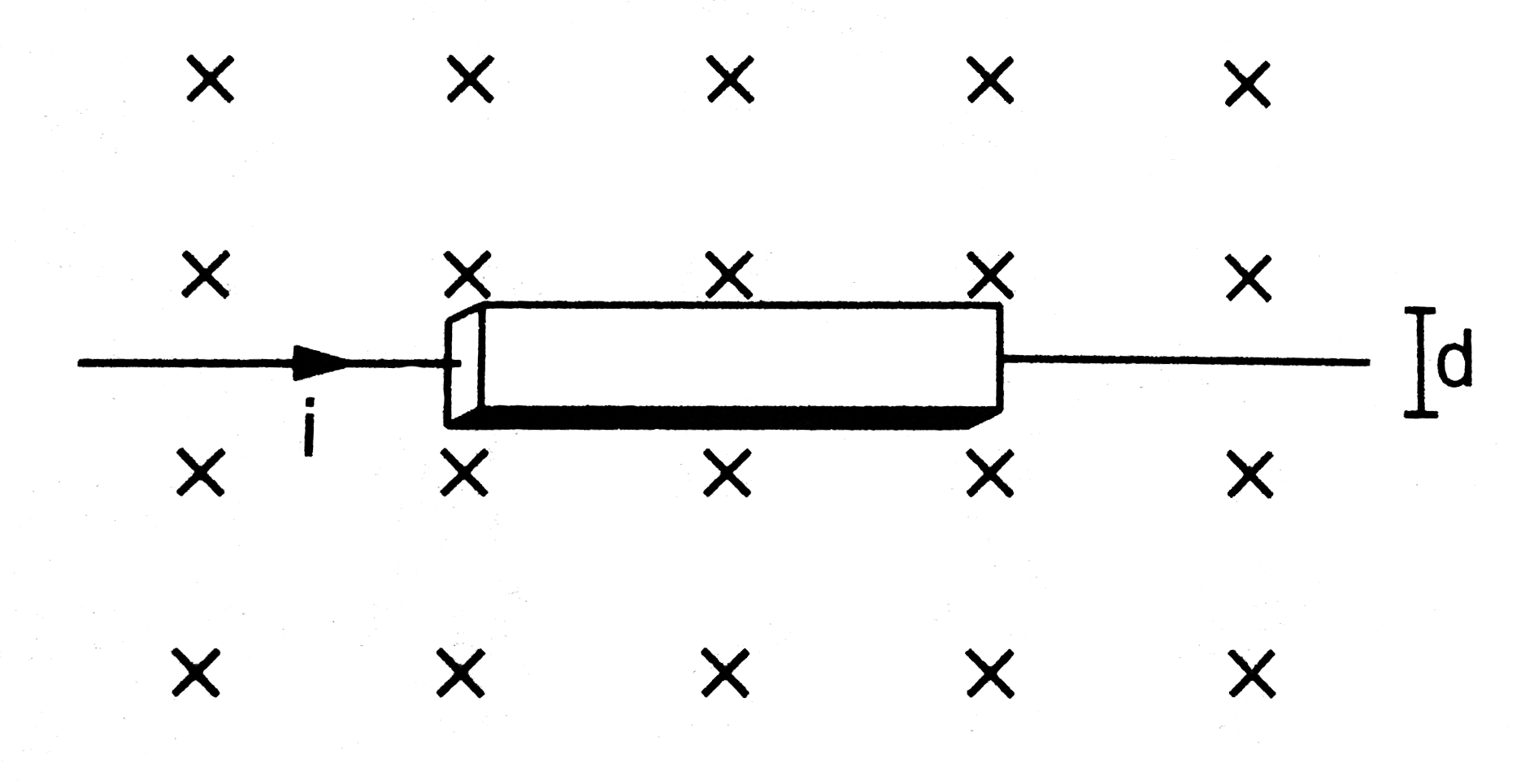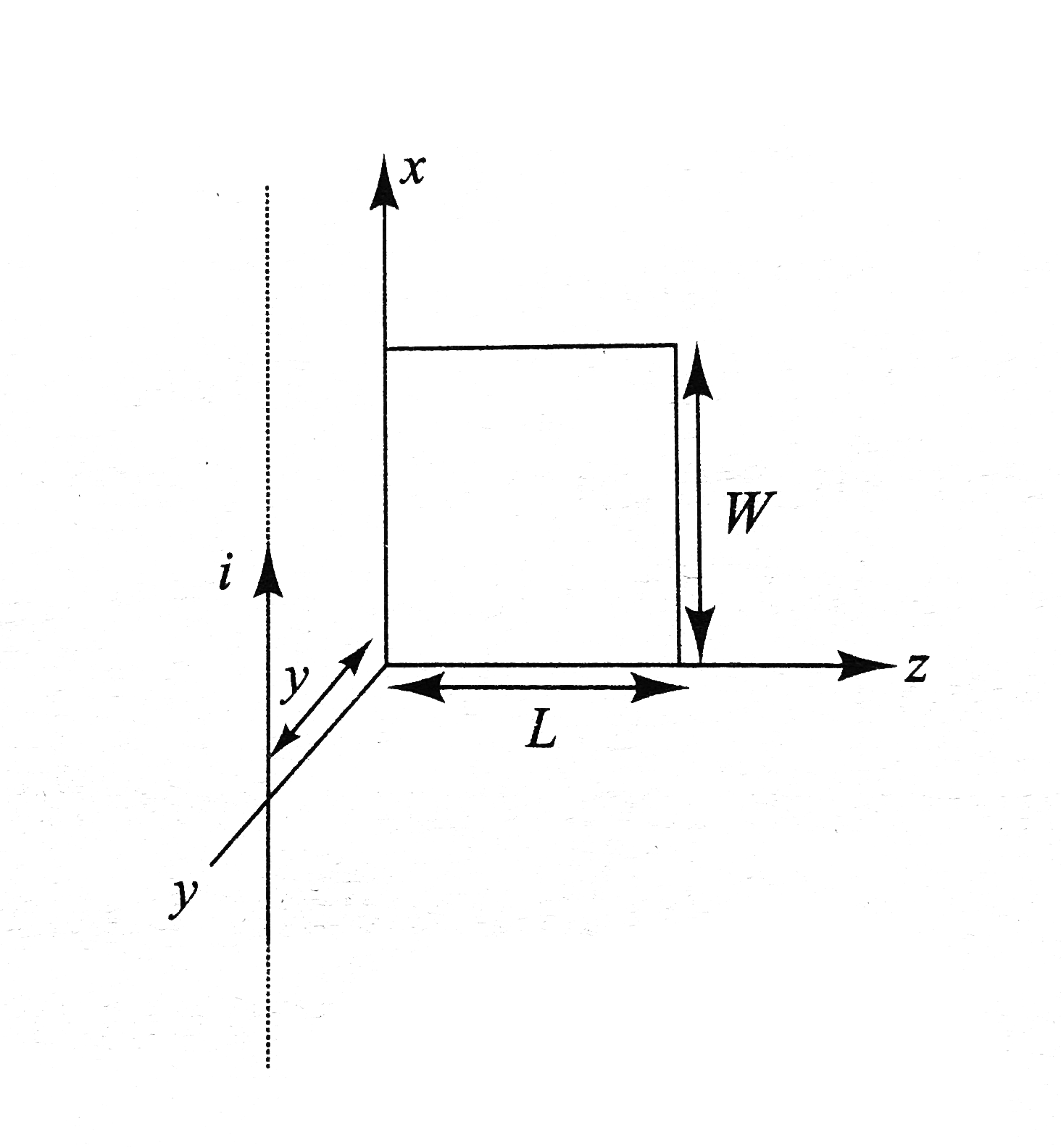A currrent I is passed through a silver strip of width d and area of cross section A. The number of free electrons per unit volume is n. (a) Find the drift velocity v of the electrons. (b) If a magnetic field B exists in the region as shown in what is the average magnetic force on the free electrons? (c) Due to the magnetic force, the free electrons get accumulated on one side of the conductor along its length. This produces a transverse electric field in the conductor which opposes the magnetic force on the electrons. Find the magnitude of the electric field which will stop further accumulation of electrons. (d)what will be the potential diference developed across the width of the conductor due to the electron- accumulation? The appearance of a transverse emf, when a current-carrying wire is placed in a magnetic field, is called hall effect.

The correct Answer is:A, B, C, D
i=neAVd
Vd=ineA=iπr2neFm=eVdB=iBnAupward
Fm=iBπ2nupward
Fm=FE
eVdB=eE
E=BVd=BineA=iBπr2ne
P.d.=Ed=BidneA=2iBπrne

Topper's Solved these Questions
- BOOK - RESONANCECHAPTER - ELECTRODYNAMICSEXERCISE - Exercise-1 PART-254videos
ELECTRODYNAMICS
- BOOK - RESONANCECHAPTER - ELECTRODYNAMICSEXERCISE - Exercise-2 PART-115videos
ELECTRODYNAMICS
- BOOK - RESONANCECHAPTER - ELECTRODYNAMICSEXERCISE - PROBLEM12videos
ELECTRODYNAMICS
- BOOK - RESONANCECHAPTER - ELECTRO MAGNETIC WAVESEXERCISE - Exercise 327videos
ELECTRO MAGNETIC WAVES
- BOOK - RESONANCECHAPTER - ELECTROMAGNETIC INDUCTIONEXERCISE - A.l.P19videos
ELECTROMAGNETIC INDUCTION
Similar Questions
Two identical magnetic dipoles of magnetic moments 1⋅0Am2 each are placed at a separation of 2m with their axes perpendicular to each other. What is the resultant magnetic field at a point midway between the dipoles?
03:11View SolutionAn α is moving along a circle of radius R with a constant angular velocity ω. Point A lies in the same plane at a distance 2R from the centre. Point A records magnetic field produced by the α-particle. If the minimum time interval between two successive time at which A records zero magnetic field is t, the angular speed ω, in terms of t, is
02:22View SolutionTwo short magnet A and B of magnetic dipole mement M1 and M2 respectively are placed as shown.The axis of A and the equatorial line of B are the same.Find the magnetic force on one magnet due to other.
 04:24View Solution
04:24View SolutionAn electromagnetic wave of frequency v=3.0MHz passes from vacuum into a dielectric medium with permittivity ε=4.0. Then
01:48View SolutionA long thin wire carrying a varying current I=i0sinωt lies at a distance y above one edge of a rectangular wire loop of length LandW lying in the x−z plane. What emf is induced in the loop?
 01:47View Solution
01:47View SolutionA currrent I is passed through a silver strip of width d and area of cross section A. The number of free electrons per unit volume is n. (a) Find the drift velocity v of the electrons. (b) If a magnetic field B exists in the region as shown in what is the average magnetic force on the free electrons? (c) Due to the magnetic force, the free electrons get accumulated on one side of the conductor along its length. This produces a transverse electric field in the conductor which opposes the magnetic force on the electrons. Find the magnitude of the electric field which will be the potential diference developed across the width of the conductor due to the electron- accumulation? The appearance of a transverse emf, when a current-carrying wire is placed in a magnetic field, is called hall effect.
 03:20View Solution
03:20View SolutionAssertion: Free electron always keep on moving in a conductor even then no magnetic force act on them in magnetic field unless a current is passed through it. Reason: The average velocity of free electron is zero.
02:20View SolutionA current of 16 A is made to pass through a conductor in which the number of density of free electrons is 4xx10^(28)m^(-3) and its area of cross section is 10^(-5)m^(2) . The average drift cross section is 10^(-5)m^(2) . The average drift velocity of free electrons in the conductor is
01:40View SolutionIf A is the area of cross section of conductor, e be the charge on the electrons, n be the number of electrons per unit volume and J be the current density then drift velocity of electrons is
02:06View SolutionIf A is the area of cross section of conductor, v_(d) is the drift velocity of electrons and n is the number of electrons per unit volume, then current density through conductor is
03:49View SolutionIf n,e,A and v_(d) are free electron density inside conductor , charge of electron , area of cross-section of conductor and drift velocity of free electrons inside conductor, then current l through the conductor is
01:33View SolutionIn a metallic conductor, the number of free electrons per unit volume is n and the drift velocity of those electrons is v_d . Then
02:30View SolutionWhen a current of 1 A flows through a copper wire of cross sectional area 1mm^2 the drift velocity of free electrons becomes v, What will be the drift velocity of free electrons when the same current flows through a copper wire of cross sectional area 2mm^2 ?
View SolutionThe number of free electrons per unit volume in a metallic conductor is 1022cm−3.The area of cross section of the conductor is 1mm2 and the strength of current through the conductor is 1A. Determine the drift velocity of the free electrons,(Given that the charge of an electron −1.6×10−19C)
View SolutionThe length of a current-carrying cylindrical conductor is l, its area of cross-section is A, the number density of free electrons in it is n, and the drift velocity of electrons in it is v_d . The number of electrons passing through a particular cross-section of the conductor per unit time is given by:
07:14View SolutionA current I is passed through a silver strip of width d and area of cross-section A. The number of free electrons per unit volume is n Find the drift velocity v of the electrons.
03:26View Solution

